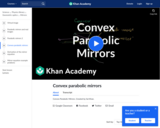
Convex Parabolic Mirrors
- Subject:
- Physical Science
- Physics
- Material Type:
- Lesson
- Provider:
- Khan Academy
- Author:
- Sal Khan
- Date Added:
- 09/22/2013

Convex Parabolic Mirrors
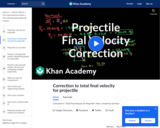
Correction to "Total Final Velocity for Projectile" Video

The students discover the basics of heat transfer in this activity by constructing a constant pressure calorimeter to determine the heat of solution of potassium chloride in water. They first predict the amount of heat consumed by the reaction using analytical techniques. Then they calculate the specific heat of water using tabulated data, and use this information to predict the temperature change. Next, the students will design and build a calorimeter and then determine its specific heat. After determining the predicted heat lost to the device, students will test the heat of solution. The heat given off by the reaction can be calculated from the change in temperature of the water using an equation of heat transfer. They will compare this with the value they predicted with their calculations, and then finish by discussing the error and its sources, and identifying how to improve their design to minimize these errors.

Students learn about the physical force of linear momentum movement in a straight line by investigating collisions. They learn an equation that engineers use to describe momentum. Students also investigate the psychological phenomenon of momentum; they see how the "big mo" of the bandwagon effect contributes to the development of fads and manias, and how modern technology and mass media accelerate and intensify the effect.
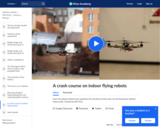
Learn the physics behind how quadrotors fly and find out how they can by themselves without human help.

Students are introduced to servos and the flex sensor as they create simple, one-jointed, finger robots controlled by Arduino. Servos are motors with feedback and are extensively used in industrial and consumer applications—from large industrial car-manufacturing robots that use servos to hold heavy metal and precisely weld components together, to prosthetic hands that rely on servos to provide fine motor control. Students use Arduino microcontrollers and flex sensors to read finger flexes, which they process to send angle information to the servos. Students create working circuits; use the constrain, map and smoothing commands; learn what is meant by library and abstraction in a coding context; and may even combine team finger designs to create a complete prosthetic hand of bendable fingers.
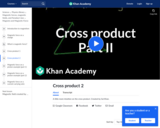
A little more intuition on the cross product.
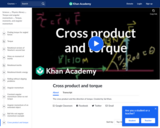
The cross product and the direction of torque.
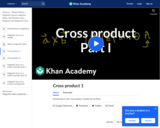
Introduction to the cross product
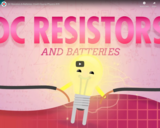
The video resource "DC Resistors & Batteries: Crash Course Physics #29" is included in the "Media Literacy" course from the resources series of "Crash Course". Crash Course is a educational video series from John and Hank Green.
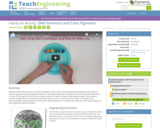
Students perform DNA forensics using food coloring to enhance their understanding of DNA fingerprinting, restriction enzymes, genotyping and DNA gel electrophoresis. They place small drops of different food coloring ("water-based paint") on strips of filter paper and then place one paper strip end in water. As water travels along the paper strips, students observe the pigments that compose the paint decompose into their color components. This is an example of the chromatography concept applied to DNA forensics, with the pigments in the paint that define the color being analogous to DNA fragments of different lengths.
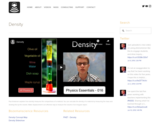
Paul Andersen explains how density measures the compactness of a material. You can calculate the density of a material by measuring the mass and dividing this by the volume. Water displacement is an effective way to measure the volume of an irregular object.
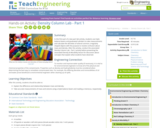
In this first part of a two-part lab activity, students use triple balance beams and graduated cylinders to take measurements and calculate the densities of several common, irregularly shaped objects with the purpose to resolve confusion about mass and density. After this activity, conduct the associated Density Column Lab - Part 2 activity before presenting the associated Density & Miscibility lesson for discussion about concepts that explain what students have observed.
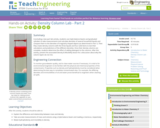
Concluding a two-part lab activity, students use triple balance beams and graduated cylinders to take measurements and calculate densities of several household liquids and compare them to the densities of irregularly shaped objects (as determined in Part 1). Then they create density columns with the three liquids and four solid items to test their calculations and predictions of the different densities. Once their density columns are complete, students determine the effect of adding detergent to the columns. After this activity, present the associated Density & Miscibility lesson for a discussion about why the column layers do not mix.
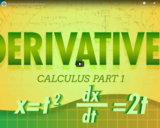
The video resource "Derivatives: Crash Course Physics #2" is included in the "Sociology" course from the resources series of "Crash Course". Crash Course is a educational video series from John and Hank Green.
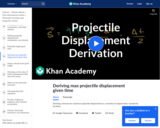
Deriving a formula for maximum projectile displacement as a function of elapsed time
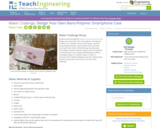
Students design and create their own nano-polymer smartphone or tablet case. Students choose their design, mix their nano-polymer (based in silicone) with starch and add coloring of their choice. While thinking critically about their design, students embed strings in the nano-polymer to optimize both case strength and flexibility. Students may apply strings in a variety of ways in order to maximize their individual design’s potential. Determining the best mixing ratio is also key for success in this challenge.

Students find and calculate the angle that light is transmitted through a holographic diffraction grating using trigonometry. After finding this angle, student teams design and build their own spectrographs, researching and designing a ground- or space-based mission using their creation. At project end, teams present their findings to the class, as if they were making an engineering conference presentation. Student must have completed the associated Building a Fancy Spectrograph activity before attempting this activity.
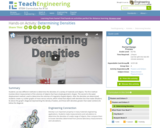
Students use two different methods to determine the densities of a variety of materials and objects. The first method involves direct measurement of the volumes of objects that have simple geometric shapes. The second is the water displacement method, used to determine the volumes of irregularly shaped objects. After the densities are determined, students create x-y scatter graphs of mass versus volume, which reveal that objects with densities less than water (floaters) lie above the graph's diagonal (representing the density of water), and those with densities greater than water (sinkers) lie below the diagonal.
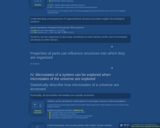
In this deterministic cellular automata model, interactions between neighboring automata are described using a prisoner's dilemma. Limiting dispersal of seeds of annual plants can permit heterogeneous co-existence, whereas thorough mixing instead allows one subpopulation to dominate quickly.